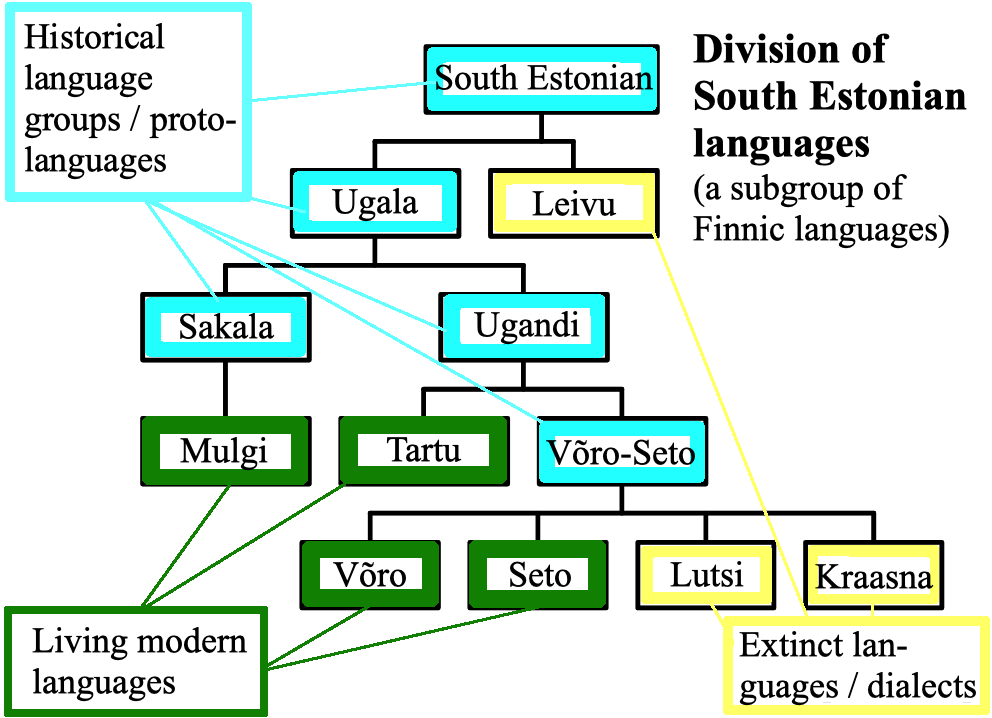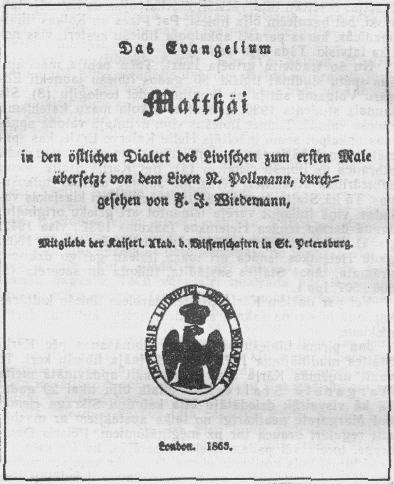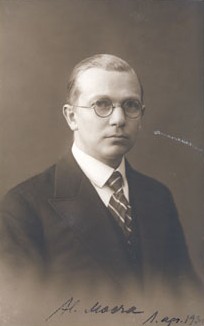|
Leivu
Gauja Estonians ( et, Koiva maarahvas, ''Leivu maarahvas'' or ''leivud''; lv, Vidzemes igauņi – 'Vidzeme Estonians' or ''leivi'') were Estonians who lived along Gauja river in Latvia. History Gauja Estonians are most likely native to their homelands. There are mentions of Chudes living in Adzele county from 12th century Russian sources. There are later mentions of them living in the Gauja river area. According to August Wilhelm Hupel's book ''Topographische Nachrichten von Lief und Ehstland'' there were about thousand Estonians in 1777. Anders Johan Sjögren claimed that there were 2,600 Gauja Estonians in 1849. Heikki Ojansuu counted only 116 when he made a trip to area in 1911. According to Ojansuu's theory, Gauja Estonians were refugees of the Great Northern War from Southern Estonia, but today this theory has been largely discredited. According to Harri Moora and Paul Ariste, Gauja Estonians were the original inhabitants of their homelands.Seppo Zerterberg: Viro, Historia ... [...More Info...] [...Related Items...] OR: [Wikipedia] [Google] [Baidu] |
Leivu Dialect
The Leivu dialect is an extinct South-Estonian dialect that was spoken in North Latvia around the Gauja river spoken by the Gauja Estonians, who became extinct in the year 1988 when the last speaker Anton Bok died. However there are many recordings of the dialect. The Leivu dialect most closely resembles the Hargla sub-dialect of Võro but was influenced by the Latvian language and possibly even Livonian. In the year 1782, the dialect was spoken by thousands of people, in 1849 around 2600 knew the dialect and in 1935 only about 131 knew or spoke it. In 1911, Finnish linguist Heikki Ojansuu went to document the Leivu dialect along with the Ludza and Kraasna dialects. Characteristics Due to Latvian influence, the sounds s and z have changed into š and ž. For example: ‘wolf’, ‘gun’. There has also been a loss of the letter H in many words and it is usually replaced by a stød such as in: ‘money’, ‘less’. The first syllable was pronounced longer than in oth ... [...More Info...] [...Related Items...] OR: [Wikipedia] [Google] [Baidu] |
South Estonian
South Estonian, spoken in south-eastern Estonia, encompasses the Tartu, Mulgi, Võro and Seto varieties. There is no academic consensus on its status, as some linguists consider South Estonian a dialect group of Estonian whereas other linguists consider South Estonian an independent Finnic language. Diachronically speaking, North and South Estonian are separate branches of the Finnic languages. Note that reconstructed *č and *c stand for affricates , . Modern Standard Estonian has evolved on the basis of the dialects of Northern Estonia. However, from the 17th to the 19th centuries in Southern Estonia, literature was published in a standardized form of Southern Tartu and Northern Võro. That usage was called Tartu or literary South Estonian. The written standard was used in the schools, churches and courts of the Võro and Tartu linguistic area but not in the Seto and Mulgi areas. After Estonia gained independence in 1918, the standardized Estonian language policies we ... [...More Info...] [...Related Items...] OR: [Wikipedia] [Google] [Baidu] |
South Estonian Language Area
South is one of the cardinal directions or compass points. The direction is the opposite of north and is perpendicular to both east and west. Etymology The word ''south'' comes from Old English ''sūþ'', from earlier Proto-Germanic ''*sunþaz'' ("south"), possibly related to the same Proto-Indo-European root that the word ''sun'' derived from. Some languages describe south in the same way, from the fact that it is the direction of the sun at noon (in the Northern Hemisphere), like Latin meridies 'noon, south' (from medius 'middle' + dies 'day', cf English meridional), while others describe south as the right-hand side of the rising sun, like Biblical Hebrew תֵּימָן teiman 'south' from יָמִין yamin 'right', Aramaic תַּימנַא taymna from יָמִין yamin 'right' and Syriac ܬܰܝܡܢܳܐ taymna from ܝܰܡܝܺܢܳܐ yamina (hence the name of Yemen, the land to the south/right of the Levant). Navigation By convention, the ''bottom or down-facing side'' of a ... [...More Info...] [...Related Items...] OR: [Wikipedia] [Google] [Baidu] |
Latvian People Of Estonian Descent
Latvian may refer to: *Something of, from, or related to Latvia **Latvians, a Baltic ethnic group, native to what is modern-day Latvia and the immediate geographical region **Latvian language, also referred to as Lettish **Latvian cuisine **Latvian culture **Latvian horse *Latvian Gambit, an opening in chess See also *Latvia (other) Latvia is a country in Europe. Latvia can also refer to: *Latvian Soviet Socialist Republic (1940–1990) *Latvia (European Parliament constituency) * 1284 Latvia - asteroid *Latvia Peak - mountain in Tajikistan Tajikistan (, ; tg, Тоҷ ... * {{disambiguation Language and nationality disambiguation pages ... [...More Info...] [...Related Items...] OR: [Wikipedia] [Google] [Baidu] |
Social History Of Estonia
Social organisms, including human(s), live collectively in interacting populations. This interaction is considered social whether they are aware of it or not, and whether the exchange is voluntary or not. Etymology The word "social" derives from the Latin word ''socii'' ("allies"). It is particularly derived from the Italian ''Socii'' states, historical allies of the Roman Republic (although they rebelled against Rome in the Social War of 91–87 BC). Social theorists In the view of Karl MarxMorrison, Ken. ''Marx, Durkheim, Weber. Formations of modern social thought'', human beings are intrinsically, necessarily and by definition social beings who, beyond being "gregarious creatures", cannot survive and meet their needs other than through social co-operation and association. Their social characteristics are therefore to a large extent an objectively given fact, stamped on them from birth and affirmed by socialization processes; and, according to Marx, in producing and reproducin ... [...More Info...] [...Related Items...] OR: [Wikipedia] [Google] [Baidu] |
Östen Dahl
Östen Dahl (; born 4 November 1945 in Stockholm) is a Swedish linguist and professor best known for pioneering a marker-based approach to tense and aspect in linguistic typology. Dahl finished his PhD at the University of Gothenburg and subsequently worked there as a docent before becoming professor of general linguistics at the University of Stockholm in 1980. Honours * Royal Swedish Academy of Sciences, member since 1997 * Royal Swedish Academy of Letters, History and Antiquities, member since 1998 * Academia Europaea, member since 2006 * honorary doctorate of philosophy from the University of Helsinki in 2003 * Norwegian Academy of Science and Letters The Norwegian Academy of Science and Letters ( no, Det Norske Videnskaps-Akademi, DNVA) is a learned society based in Oslo, Norway. Its purpose is to support the advancement of science and scholarship in Norway. History The Royal Frederick Unive ..., member Works * Tense and Aspect Systems'' Oxford: Blackwell, 1985 * e ... [...More Info...] [...Related Items...] OR: [Wikipedia] [Google] [Baidu] |
Livonian Language
The Livonian language ( liv, līvõ kēļ, link=no or ; et, liivi keel, link=yes) is a Finnic language whose native land is the Livonian Coast of the Gulf of Livonia, located in the north of the Kurzeme peninsula in Latvia. Although its last native speaker died in 2013, there are about 40 reported L2 speakers and 210 having reported some knowledge of the language. Possibly uniquely among the Uralic languages, Livonian has been described as a pitch-accent language (see below). Currently, the only person whose native language is Livonian is Kuldi Medne who was born in 2020. Her parents are Livonian language revival activists Jānis Mednis and Renāte Medne. Some ethnic Livonians are learning or have learned Livonian in an attempt to revive it, but because ethnic Livonians are a small minority, opportunities to use Livonian are limited. The Estonian newspaper '' Eesti Päevaleht'' erroneously announced that Viktors Bertholds, who died on 28 February 2009, was the last native ... [...More Info...] [...Related Items...] OR: [Wikipedia] [Google] [Baidu] |
Hargla
Hargla ( vro, Harglõ) is a village in Valga Parish, Valga County in southern Estonia. (retrieved 28 July 2021) As of 2011 Census, the settlement's population was 169. Gallery File:Hargla kõrtsihoone 2013.JPG, Hargla inn File:Harglõ postkontor.JPG, Hargla post office File:20120810 Harglõ kalmuaid.JPG, Hargla cemetery File:Hargla kool 02.JPG, Hargla School References Villages in Valga County Valga Parish Kreis Werro {{valga-geo-stub ... [...More Info...] [...Related Items...] OR: [Wikipedia] [Google] [Baidu] |
Anton Bok
Anton may refer to: People *Anton (given name), including a list of people with the given name *Anton (surname) Places *Anton Municipality, Bulgaria **Anton, Sofia Province, a village *Antón District, Panama **Antón, a town and capital of the district *Anton, Colorado, an unincorporated town *Anton, Texas, a city *Anton, Wisconsin, an unincorporated community *River Anton, Hampshire, United Kingdom Other uses * Case Anton, codename for the German and Italian occupation of Vichy France in 1942 *Anton (computer) Anton is a massively parallel supercomputer designed and built by D. E. Shaw Research in New York, first running in 2008. It is a special-purpose system for molecular dynamics (MD) simulations of proteins and other biological macromolecules. ..., a highly parallel supercomputer for molecular dynamics simulations * ''Anton'' (1973 film), a Norwegian film * ''Anton'' (2008 film), an Irish film * Anton Cup, the championship trophy of the Swedish junior hockey ... [...More Info...] [...Related Items...] OR: [Wikipedia] [Google] [Baidu] |
Paul Ariste
Paul Ariste (3 February 1905 – 2 February 1990) was an Estonian linguist renowned for his studies of the Finno-Ugric languages (especially Estonian and Votic), Yiddish and Baltic Romani language. He was born as Paul Berg, in Rääbise, Võtikvere Parish (now Jõgeva Parish), Kreis Dorpat, Governorate of Livonia, Russian Empire, but in 1927 Estonized his name to Ariste. He graduated from the University of Tartu and subsequently worked with it. Ariste wrote his M.A. thesis ("Eesti-rootsi laensõnad eesti keeles") on Swedish – viz. Estonian Swedish dialect – loanwords in Estonian, his doctoral thesis ("Hiiu murrete häälikud") treated the Hiiumaa dialect of Estonian language. From 1945 to 1946, Ariste was imprisoned by the Soviet authorities (for having been member of '' Veljesto'', a student association in independent Estonia) Since 1927 Paul Ariste eagerly participated in activities of Estonian Folklore Archives, where he established collections of Jewish, Sw ... [...More Info...] [...Related Items...] OR: [Wikipedia] [Google] [Baidu] |
Harri Moora
Harri Moora ( in Ehavere, Kuremaa Parish – 2 May 1968 in Tallinn) was an Estonian archaeologist. He was a recipient of the national Cross of Liberty. In 1925, he graduated from the University of Tartu. Between 1930–1942, he was a museum director. In 1931, he studied at Baltic Institute in Stockholm and developed a scholarly working relationship with Finnish archaeologist Ella Kivikoski, who was one of his main contacts with Scandinavian archaeologists. He worked at Tartu University during World War II World War II or the Second World War, often abbreviated as WWII or WW2, was a world war that lasted from 1939 to 1945. It involved the World War II by country, vast majority of the world's countries—including all of the great power ... but was arrested in 1944; he resumed his post at the university after the war. He worked at the Institute of History and Archaeology as the department head until his death. From 1936 to 1950 he was Chairman of the Estonian ... [...More Info...] [...Related Items...] OR: [Wikipedia] [Google] [Baidu] |
Great Northern War
The Great Northern War (1700–1721) was a conflict in which a coalition led by the Tsardom of Russia successfully contested the supremacy of the Swedish Empire in Northern, Central and Eastern Europe. The initial leaders of the anti-Swedish alliance were Peter I of Russia, Frederick IV of Denmark–Norway and Augustus II the Strong of Saxony– Poland–Lithuania. Frederick IV and Augustus II were defeated by Sweden, under Charles XII, and forced out of the alliance in 1700 and 1706 respectively, but rejoined it in 1709 after the defeat of Charles XII at the Battle of Poltava. George I of Great Britain and the Electorate of Hanover joined the coalition in 1714 for Hanover and in 1717 for Britain, and Frederick William I of Brandenburg-Prussia joined it in 1715. Charles XII led the Swedish army. Swedish allies included Holstein-Gottorp, several Polish magnates under Stanislaus I Leszczyński (1704–1710) and Cossacks under the Ukrainian Hetman Ivan Mazepa (1708 ... [...More Info...] [...Related Items...] OR: [Wikipedia] [Google] [Baidu] |



